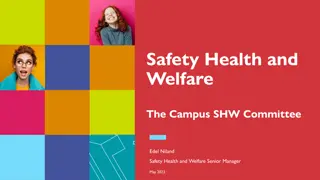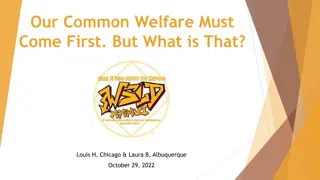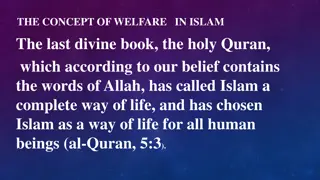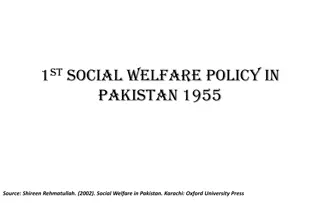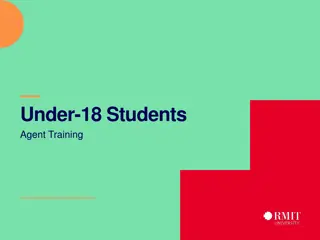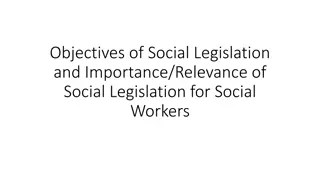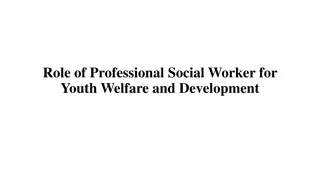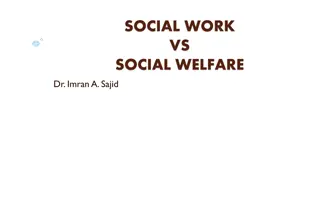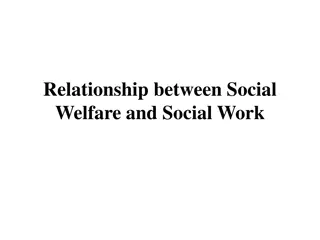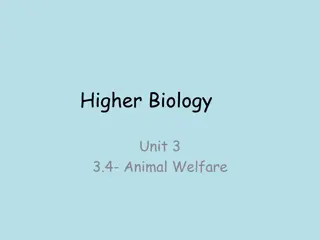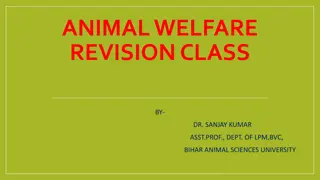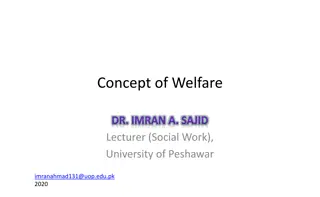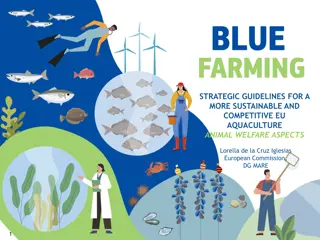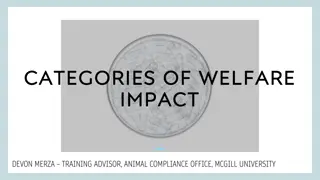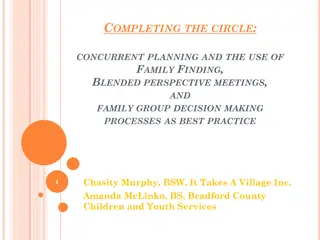Importance of the Right to Education in Social Welfare Policies
The right to education is a fundamental human right recognized in various international conventions and laws. It includes provisions for free, compulsory primary education, accessible secondary education, and equitable higher education. Upholding this right is crucial for promoting equality, fostering respect for human rights, and ensuring peaceful coexistence among nations. The obligation to provide basic education extends to individuals of all levels, emphasizing non-discrimination and quality education standards.
Download Presentation

Please find below an Image/Link to download the presentation.
The content on the website is provided AS IS for your information and personal use only. It may not be sold, licensed, or shared on other websites without obtaining consent from the author. Download presentation by click this link. If you encounter any issues during the download, it is possible that the publisher has removed the file from their server.
E N D
Presentation Transcript
Social Welfare Administration-I 1. Concept and Approaches of Social Welfare 2. Social Welfare Policies
Social Welfare Policies 1. 2. Right to Education National Health Mission
Right to Education The right to education has been recognized as a human right in a number of international conventions, including the International Covenant on Economic, Social and Cultural Rights which recognizes a right to free, compulsory primary education for all, an obligation to develop secondary education accessible to all, on particular by the progressive introduction of free secondary education, as well as an obligation to develop equitable access to higher education, ideally by the progressive introduction of free higher education. Today, almost 75 million children across the world are prevented from going to school each day. As of 2015, 164 states were parties to the Covenant. The right to education also includes a responsibility to provide basic education for individuals who have not completed primary education from the school and college levels. In addition to these access to education provisions, the right to education encompasses the obligations of the students to avoid discrimination at all levels of the educational system, to set minimum standards of education and to improve the quality of education.
The right to education is reflected in international law in Article 26 of the Universal Declaration of Human Rights and Articles 13 and 14 of the International Covenant on Economic, Social and Cultural Rights. Article 26 states: "Everyone has the right to education. Education shall be free, at least in the elementary and fundamental stages. Elementary education shall be compulsory. Technical and professional education shall be made generally available and higher education shall be equally accessible to all on the basis of merit. Education shall be directed to the full development of the human personality and to the strengthening of respect for human rights and fundamental freedoms. It shall promote understanding, tolerance and friendship among all nations, racial or religious groups, and shall further the activities of the United Nations for the maintenance of peace. Parents have a prior right to choose the kind of education that shall be given to their children."
The right to education has been reaffirmed in the 1960 UNESCO Convention against Discrimination in Education, the 1981 Convention on the Elimination of All Forms of Discrimination Against Women, the 2006 Convention on the Rights of Persons with Disabilities, and theAfrican Charter on Human and Peoples' Rights. In Europe, Article 2 of the first Protocol of 20 March 1952 to the European Convention on Human Rights states that the right to education is recognized as a human right and is understood to establish an entitlement to education. According to the International Covenant on Economic, Social and Cultural Rights, the right to education includes the right to free, compulsory primary education for all, an obligation to develop secondary education accessible to all in particular by the progressive introduction of free secondary education, as well as an obligation to develop equitable access to higher education in particular by the progressive introduction of free higher education. The right to education also includes a responsibility to provide basic education for individuals who have not completed primary education. In addition to these access to education provisions, the right to education encompasses also the obligation to eliminate discrimination at all levels of the educational system, to set minimum standards, and to improve quality. The European Court of Human Rights in Strasbourg has applied this norm for example in the Belgian linguistic case. Article 10 of the European Social Charter guarantees the right to vocational education. Education in India is provided by the public sector as well as the private sector, with control and funding coming from three levels: federal, state, and local. The Nalanda University was the oldest university-system of education in the world. Western education became ingrained into Indian society with the establishment of the British Raj.
The Constitution (Eighty-sixth Amendment) Act, 2002 inserted Article 21-A in the Constitution of India to provide free and compulsory education of all children in the age group of six to fourteen years as a Fundamental Right. The Right of Children to Free and Compulsory Education Act or Right to Education Act (RTE), is an Act of the Parliament of India enacted on 4 August 2009, which describes the modalities of the importance of free and compulsory education for children between 6 and 14 in India under Article 21a of the Indian Constitution. India became one of 135 countries to make education a fundamental right of every child when theAct came into force on 1April 2010. The title of the RTE Act incorporates the words free and compulsory. Free education means child does not require to pay any fee for his or her education. Compulsory education casts an obligation on the appropriate Government and local authorities to provide and ensure admission, attendance and completion of elementary education by all children in the 6-14 age group. Apart from the clause on Free and Compulsory Education, it specifies the duties and responsibilities of appropriate Governments, local authority and parents in providing free and compulsory education, and sharing of financial and other responsibilities between the Central and State Governments. It lays down the norms and standards relating inter alia to Pupil Teacher Ratios (PTRs), buildings and infrastructure, school-working days, teacher-working hours.
It provides for rational deployment of teachers by ensuring that the specified pupil teacher ratio is maintained for each school, rather than just as an average for the State or District or Block, thus ensuring that there is no urban-rural imbalance in teacher postings. It also provides for prohibition of deployment of teachers for non-educational work, other than decennial census, elections to local authority, state legislatures and parliament, and disaster relief. The Act provides for appointment of appropriately trained teachers, i.e. teachers with the requisite entry and academic qualifications. It prohibits (a) physical punishment and mental harassment; (b) screening procedures for admission of children; (c) capitation fee; (d) private tuition by teachers and (e) running of schools without recognition,
The RTE Act provides for development of curriculum in consonance with the values enshrined in the Constitution, and which would ensure the all-round development of the child, building on the child s knowledge, potentiality and talent and making the child free of fear, trauma and anxiety through a system of child friendly and child centred learning.
National Health Mission The National Health Mission (NHM) was launched by the government of India in 2013 subsuming the National Rural Health Mission and National Urban Health Mission. It was further extended in March 2018, to continue until March 2020. It is headed by Mission Director and monitored by National Level Monitors appointed by Government of India. The National Rural Health Mission (NRHM), now under National Health Mission[1] is an initiative undertaken by the government of India to address the health needs of under-served rural areas. Launched on 12 April 2005 by then Indian Prime Minister Manmohan Singh, the NRHM was initially tasked with addressing the health needs of 18 states that had been identified as having weak public health indicators. The Union Cabinet headed by Dr. Manmohan Singh vide its decision dated 1 May 2013, has approved the launch of National Urban Health Mission (NUHM) as a Sub-mission of an overarching National Health Mission (NHM), with National Rural Health Mission (NRHM) being the other Sub-mission of National Health Mission.
Under the NRHM, the Empowered Action Group (EAG) States as well as North Eastern States, Jammu and Kashmir and Himachal Pradesh have been given special focus. The thrust of the mission is on establishing a fully functional, community owned, decentralized health delivery system with inter-sectoral convergence at all levels, to ensure simultaneous action on a wide range of determinants of health such as water, sanitation, education, nutrition, social and gender equality. Institutional integration within the fragmented health sector was expected to provide a focus on outcomes, measured against Indian Public Health Standards for all health facilities. As per the 12th Plan document of the Planning Commission, the flagship programme of NRHM will be strengthened under the umbrella of National Health Mission. The focus on covering rural areas and rural population will continue along with up scaling of NRHM to include non-communicable diseases and expanding health coverage to urban areas. Accordingly, the Union Cabinet, in May 2013, has approved the launch of National Urban Health Mission (NUHM) as a sub-mission of an overarching National Health Mission (NHM), with National Rural Health Mission (NRHM) being the other sub-mission of the National Health Mission. It was further extended in March 2018, to continue till March 2020.
Some of the major initiatives under National Health Mission (NHM) are as follows: Accredited Social Health Activists Community Health volunteers called Accredited Social Health Activists (ASHAs) have been engaged under the mission for establishing a link between the community and the health system. ASHA is the first port of call for any health related demands of deprived sections of the population, especially women and children, who find it difficult to access health services in rural areas. ASHA Programme is expanding across States and has particularly been successful in bringing people back to Public Health System and has increased the utilization of outpatient services, diagnostic facilities, institutional deliveries and inpatient care.
Rogi Kalyan Samiti (Patient Welfare Committee) / Hospital Management Society The Rogi Kalyan Samiti (Patient Welfare Committee) / Hospital Management Society is a management structure that acts as a group of trustees for the hospitals to manage the affairs of the hospital. Financial assistance is provided to these Committees through untied fund to undertake activities for patient welfare. Untied Grants to Sub-Centres Untied Grants to Sub-Centers have been used to fund grass-root improvements in health care. Some examples include: Improved efficacy of Auxiliary Nurse Midwives (ANMs) in the field that can now undertake better antenatal care and other health care services. Village Health Sanitation and Nutrition Committees (VHSNC) have used untied grants to increase their involvement in their local communities to address the needs of poor households and children.
Health care contractors NRHM has provided health care contractors to underserved areas, and has been involved in training to expand the skill set of doctors at strategically located facilities identified by the states. Similarly, due importance is given to capacity building of nursing staff and auxiliary workers such as ANMs. NHM also supports co-location of AYUSH services in Health facilities such as PHCs, CHCs and District Hospitals.
Janani SurakshaYojana Janani Suraksha Yojana (JSY) is a safe motherhood intervention scheme implemented by the Government of India. It was launched on 12 April 2005 by the Prime Minister of India. It aims to promote institutional delivery among poor pregnant women and to reduce neo-natal mortality and maternal mortality. It is operated under the Ministry of Health and Family Welfare as part of the National Rural Health Mission. The Scheme integrates cash assistance with delivery and post- delivery care, particularly in states with low institutional delivery rates. In 2014 -15, 10,438,000 women obtained benefits under the scheme. As per the World Health Organisation, the proportion of institutional deliveries in India almost tripled between 2005 and 2016, from 18% to 52%.
Components of the Scheme The Janani Suraksha Yojana was implemented to ensure that pregnant women who are Below the Poverty Line (BPL) access health facilities for childbirth. It provides cash benefit to eligible pregnant women if they choose to deliver in a health facility, irrespective of their age and the number of children they have. Special dispensation is provided to states that have low institutional delivery rates. These states are Uttar Pradesh, Uttarakhand, Bihar, Jharkhand, Madhya Pradesh, Chhattisgarh, Assam, Rajasthan, Odisha, and Jammu and Kashmir, and are referred to as Low Performing States (LPS) under the Scheme.[10] Other states and Union Territories are called High Performing States (HPS) owing to their higher institutional delivery rates. Accredited Social Health Activists (ASHA) are also incentivised under the Scheme for promoting institutional deliveries among pregnant women.
National Ambulance Services Free ambulance services are provided in every nook and corner of the country connected with a toll free number and reaches within 30 minutes of the call. Janani Shishu Suraksha Karyakram (JSSK) As part of recent initiatives and further moving in the direction of universal healthcare, Janani Shishu Suraksha Karyakarm (JSSK) was introduced to provide free to and fro transport, free drugs, free diagnostic, free blood, free diet to pregnant women who come for delivery in public health institutions and sick infants up to one year.
Rashtriya Bal Swasthya Karyakram (RBSK) A Child Health Screening and Early Intervention Services has been launched in February 2013 to screen diseases specific to childhood, developmental delays, disabilities, birth defects and deficiencies. The initiative will cover about 27 crore children between 0 18 years of age and also provide free treatment including surgery for health problems diagnosed under this initiative. Mother and Child Health Wings (MCH Wings) With a focus to reduce maternal and child mortality, dedicated Mother and Child Health Wings with 100/50/30 bed capacity have been sanctioned in high case load district hospitals and CHCs which would create additional beds for mothers and children.
Free Drugs and Free Diagnostic Service A new initiative is launched under the National Health Mission to provide Free Drugs Service and Free Diagnostic Service with a motive to lower the out of pocket expenditure on health. District Hospital and Knowledge Center (DHKC) As a new initiative District Hospitals are being strengthened to provide Multi-specialty health care including dialysis care, intensive cardiac care, cancer treatment, mental illness, emergency medical and trauma care etc. These hospitals would act as the knowledge support for clinical care in facilities below it through a tele-medicine center located in the district headquarters and also developed as centers for training of paramedics and nurses.
National Iron+ Initiative The National Iron+ Initiative is an attempt to look at Iron Deficiency Anaemia in which beneficiaries will receive iron and folic acid supplementation irrespective of their Iron/Hb status. This initiative will bring together existing programmes (IFA supplementation for: pregnant and lactating women and; children in the age group of 6 60 months) and introduce new age groups. Tribal TB Eradication Project This project is launched by MoS Health Shri Faggan Singh Kulaste at Mandla on 20 January 2017.


